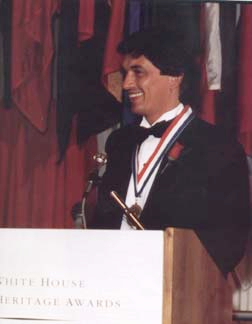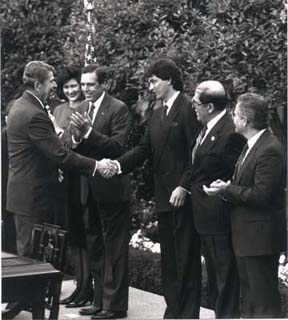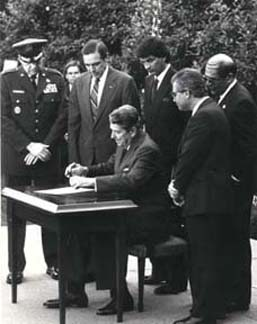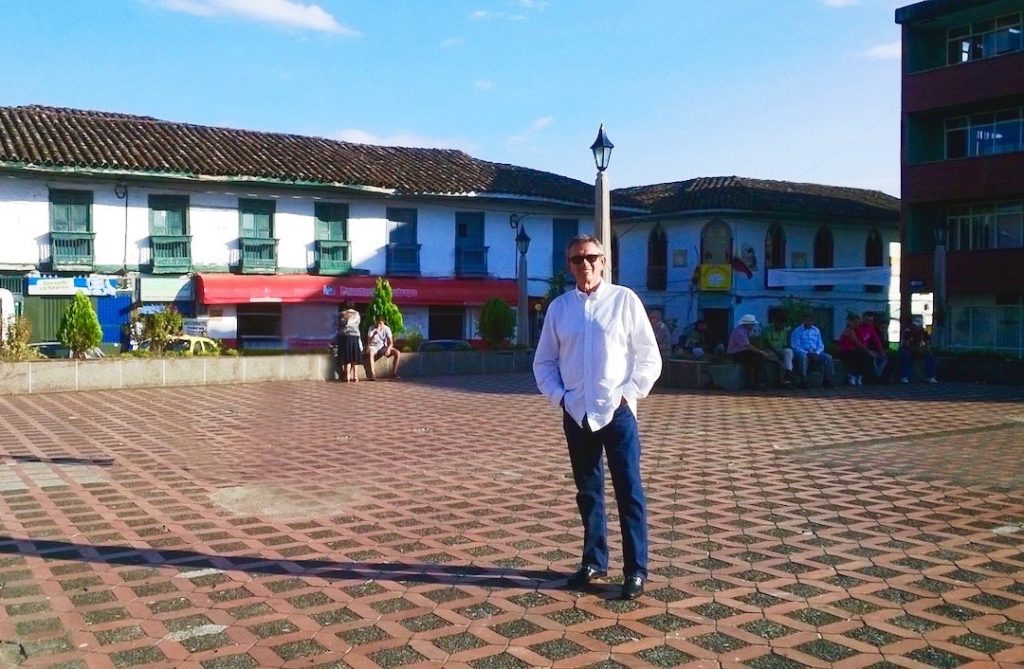CHRONOLOGY
ORLANDO AGUDELO-BOTERO
Orlando Agudelo-Botero in his birthplace, Anserma Caldas, Colombia, South America
WHAT DO YOU THINK OF LIFE?
The decade of the nineteen-fifties was ending and anticipation for the new decade which promised to change it all was in the air.
It was then, that in the dining room of the home of Felix Maria Agudelo, his children were exercising their imagination by playing an innocent game which would help open lines of communication amongst all the brothers and sisters. At these daily gatherings, Alberto, one of the older brothers would surprise the younger ones with the question… What do you think of life? The results were always a variety of answers, perplexed faces, childish giggles or absolute indifference. Among these twelve brothers and sisters, this question would forever mark the mind of the eighth child, the one who by nature, years later, would be the painter.
In Anserma Viejo, Caldas, a small town carved in the Andes Mountains of Colombia, a terrain of fertile lands and producer of some of the rich coffee beans that have covered the world, the boy whose destiny would be to bring through his art that question to others was born.
The first glimpses of light to illuminate the path of this child began to light up slowly, gradually increasing its strength to full capacity. First ignited by his parents and nurtured by all the people who contributed to his existence, it grew to become a fountain, a generator of warmth and light that touched and illuminated others with the same intensity of his very first memory, the fire.
THE FIRST IMPRESSION
One evening while in the arms of his father and in the company of his mother, Maria Luisa Botero and sister, heir to the same name, he watched from the balcony of his parents residence as the house across the street, home to the Rivillas family was being consumed by a gigantic fire generating heat and flames that united and illuminated their faces, outlining the serenity of his father and the stamina in his mother, framed by the uneasiness and perpetual cry of his sister.
This child of only two years of age could not know that one year later on that same balcony he would live yet another experience which would become the vehicle for his first indirect encounter with a symbol of faith and religion.
THE PROMISE
On a Tuesday afternoon, while blowing bubbles with his siblings on the balcony, he lost his balance as he reached out to catch the bubbles before the breeze playfully moved them away, falling from the balcony to the cobblestone street below causing him to lose consciousness. As he fell, the expressions on the faces of his brother Fernando, his sisters Fabiola and Beatriz, and the sound of the impact as body and ground met are memories that became a part of his soul and being. Hours later, he awoke to his mothers voice, who, overwhelmed with tears of joy and in an act of thanksgiving made the promise that would commit him to a symbol of Christian faith for a period of two years to wear the robe of Francis of Assisi. This garment, part of a religious tradition symbolizing humility was not coincidental in his life for at the time of birth, this boy had been baptized with the name of Francisco Orlando Agudelo Botero.
THE AWAKENING
From the very beginning, the arts were always a part of his life. During his childhood, every Sunday morning the notes in the waltzes of Johann Strauss would filter through the walls, climbing the staircase to the second floor and down the corridor to his bedroom. Downstairs, his father waited as the children would abandon their beds to join him before attending church services. It was this tradition which would awaken in the young painter his sensibility to the expression and communication of the sounds of classical music, a permanent element found in the lines and form of his works.
As a young boy, his constant companions were imagination, creativity and happiness, taking him by the hand through the streets of his home town like mute witnesses to an omen of independence, a characteristic that would mark his personality for the rest of his life.
HIS PERSONALITY
On August 29th of 1958 his mother died. The family dynamics changed and his first signs of independence were established as his quest for search and discovery had begun. In June of 1959, without his father’s consent, Orlando left his paternal home for the home of Bernarda, his maternal grandmother, a symbol of authority and firmness.
During the short time spent at his grandmother’s home, this young boy would successfully achieve a part of his goal by quietly entering the library reserved for his uncle Adalberto; a theologian and philosopher by education. Once there, overflowing with curiosity, he would look at the hundreds of books surrounding the room. He noticed how the eyes in the images of twelve oil paintings displayed on the walls would follow him like a magnet, increasing his curiosity and nurturing his imagination. Though unaware of it at the time, through these paintings, he was establishing a communication with the twelve philosophers whose thoughts advanced mankind’s cultural endeavors. The answers were in the books and this information would later become an instrument used by the painter to unite form, music and word, initiating a cycle of spiritual growth.
THE FIRST INTROVERSION
After his return to his fathers house, the discipline over this first act of independence was to remain indoors for a thirty day period without any contact with the world apart from his home. But once again his artistic nature opened the windows of his imagination, changing what had been conceived as a disciplinary measure to be the cocoon which initiated the metamorphosis that later would give birth to the painter. During his isolation, with great enthusiasm and dedication the new forms and lines in his drawings displayed the evolution of a world previously lived by others. Through some art books, the masters of the Italian renaissance had become his loyal and faithful friends, igniting within him new curiosities, stimulating his artistic nature and tracing new frontiers which later his mentors would help him reach.
HIS ORIENTATION
While the Jesuits were cultivating in the man the seed of education, the amalgam of components in the clay that gave form to the painter were ready to be molded. The miracle maker and first mentor whose firm love and dedication would turn the painter into an artist was about to enter his path. One afternoon as he walked to his brother Mario’s house, an unexpected encounter changed his life. Senora, Dona Maruja Uribe de Restrepo, a lady whose eyes embodied the blessed insanity of someone who dares to be different invited him to visit her country home, El Retiro. From that time on, at the hour of five o’clock of every Thursday afternoon while sitting in her beautiful garden, the words of Doña Maruja slowly transformed his ability into art, sensibility into talent and creativity into genius, awakening in the artist his inner self. As a result, Orlando saw the beautiful house sitting all alone at the top of the hill as a sacred temple that treasured universal knowledge.
In life’s natural process all roads bring us to a turning point where we are faced with the decision of defining our future. After accepting his nature the Artists will was strengthened by words etched in his mind forever Orlando, there is a time in the life of every person in which you must disobey. You must go on, see the world, learn about new cultures, listen to other human beings, create your life and use your art to understand and to communicate. As these words of advice were being spoken, the wise lady remembered the basis with which the young man had been formed, knowing that he would use her advice responsibly. That afternoon, the lessons came to a conclusion as Señora Maruja Uribe de Restrepo showed Orlando his path, and in doing so, she gave the world an artist.
HIS INDEPENDENCE
The office of Felix Maria Agudelo was an extension of himself. Books and documents placed in perfect order filled the traditional desk and colonial furniture made of solid hand carved wood and rich leather. On January 12th of 1968 Orlando came to this place, conscious of the step he was about to take and aware of the consequences that could result from expressing his new position before his paternal authority. Nervously he communicated to his father that after a period of three years of planning his moment of departure had arrived. His father firmly questioned Orlando’s words, looking for any sign that would provide him with the opportunity to persuade him to stay, but instead, he felt the security and firmness of his son’s decision. Once again, the man who had dedicated his life to his twelve children demonstrated that although he did not completely understand Orlando’s artistic nature he finally accepted that his son had to follow his destiny. The following morning, Orlando Agudelo Botero, the harvest of a town carved in the South American Andes, gathered his belongings preparing for a journey that would take him to the United States of America. He left taking with him a case containing his paints and brushes, the teachings of his mentors and the love of his family. Within him, he carried an innate passion for adventure and discovery and a driving force and inner strength which would help him find the answer to the question from his childhood…
What do you think of life…?
TWENTY YEARS LATER
The White House is an architectural icon, a symbol of the free world and an extension of the people whom it represents. Inside, the presence and contribution of those human beings who have lived in it is felt throughout. This historic labyrinth conserves the essence of a nation which recognizes and stimulates excellence in society. In homage to the contributions performed by Hispanic immigrants, the Hispanic Heritage Award was constituted becoming the highest honor reserved for a Hispanic immigrant in the United States of America. In 1988 Orlando Agudelo Botero was presented with this award, twenty years after his departure from his home country.



Orlando receives the Hispanic Heritage Award for the Visual Arts from President Ronald Reagan in a Rose Garden Ceremony
THE STRUCTURE
During those two decades, the exposure and presentation of his art was essential. It was then that Elfi La Fargue, a German immigrant of Jewish origin fulfilled such a mission. This woman perceived an under current of a unique creative energy that lay discreetly in his paintings that were being presented at an art festival in the spring of 1973 in Westwood, Los Angeles California. She became the sensitive stream needed to bring his artworks to be appreciated by the eyes of thousands.
In balancing nature, the creator of the universe, has blessed humans with intellectual and creative abilities which contribute to a universal order. As a member of such a structure, Orlando is part of that balance; his creative process reveals to him information which he communicates through his art. In it, the search, the discovery and the essence of life itself is realized with the natural eloquence of a new light.
This was recognized by Glenn Engman, a human kaleidoscope of abilities with the vision to present Orlando’s art to the world while conserving and respecting the sensitivity of the art and the artist. He entered the Artists life, providing him with an arena reserved for those with the innate need to make of their lives a creation as a result of a quest for the truth in life.
THE METAMORPHOSIS
Traveling from Los Angeles to San Francisco, from north to south and from east to west, Orlando lived days which became months and years of perseverance. Understanding and accepting the need to join an already established market, he worked with anticipation, learning and developing an unbreakable discipline which gave his art the continuity needed to reach an audience, following its natural evolution.
The studio became the center of his existence. The concept of time during the process of creation ceased to exist, forever making one of day and night and in symphony; the rays of sunshine announcing dusk and dawn illuminated the studio melting the musical notes of the classical masters into his soul and art.
The classics continued being his faithful companion. Those Sunday mornings of yesteryear had become essential in his life.
Hoping to further understand the fusion of sound and movement lead him to ballet studios where he researched, studied and drew the grace, rhythm and technique in the individual dancer’s artistic expression. This art form inspired his own expression giving it the freedom of perpetual movement that takes us to an infinity which has no beginning, and no end.
THE NEW SUN
Pursuing all which was joyful and beautiful in life as a source of creative energy he realized a childhood dream by going to that place where east and west blend together, framing man and culture in a mystical environment where the eloquence of silence and the grace of nature become a sublime creation. The artist, who had already begun to define himself as an island, found his spiritual communion in Hawaii, a place which continues to be a sanctum of importance in his life.
THE LIBERATION
It was spring time; after a long cycle of deep introspection in the Hawaiian Islands, a new venture took him to New York City, the melting pot of all cultures, and a place where the artist during a visit to the Museum of Modern Art would experience a liberating force. While admiring works by the Masters of the French Renaissance he found himself lost and walking in the opposite direction to the established flow of visitors who were viewing the exhibition. In his attempt to find his way, suddenly, the art of Pablo Picasso stood before him. The impact disrobed the man while it elevated his artistic and intellectual creative power reinforcing his innate need to discover and strengthen his faith in dimensions beyond that classified as reality.
Like a reservoir of fresh waters, a fountain of creativity emanated from within opening the doors to his imagination allowing free expression of all which was the very center and fiber of his being. The light took form in his canvases illuminating the road of the Maestro. With the new freedom, religion lost its name, liberating the spirit. The man, together with the mystic, the philosopher, the musician and the painter in perfect equilibrium created a sonata that paid homage to the nobility of the trees, painting frontiers with new possibilities towards an unfolded future to be explored in the evolutionary process.
Communication, eloquence, and the power of truth became tangible in his life and in his expression. Now it had to be transmitted to those who would be the recipients of his findings.
His art initiated its journey throughout the world; New York City provided him with the platform that would allow other continents to see the essence of the artist. In the meantime, his natural need to aid others in their evolving process of discovery and his concerns for social issues took him to a number of schools and colleges using his art to communicate and emphasize his message of truth, awareness and education.
VOCATION
As in all which embodies life itself, his thoughts, cultivated with patience, care and dedication, are directed to the study of the equilibrium of nature and the genesis of creation. We human beings, members of this perfect structure must initiate the search, find answers, discover the genesis and enrich all creation. As he evolved, the themes and subject matters in his work defined the artist and gave the man his vocation. He made of his art a vehicle which conveyed information accumulated throughout his life. His creativity, his beliefs and his essence had reached a level of clarity that could be seen and felt through his art in thought provoking terms. In inspiring and challenging us to reach new schools of thought, his appeal to evolve to higher levels of existence and to create a better quality of life became a priority in his works.
THE RETURN HOME
One day, while speaking to a group of young students a contemplative mood took him back to the beginning of his journey and the first road, highlighted by the bright and beautiful color pencils that his uncle, Ebel Botero, had given him when he was seven years old. As he traveled on this road he met once again with Gabriel Pelaez, a good friend of his hometown; they reminisced and laughed happily as they recalled anecdotes of their school days and spoke of the French Renaissance art books with which Gabriel had enlightened his path. As he continued in his retrospective, he found himself entering the home of his childhood. In the dining room was his father, looking respectful and serene while his mother, jovial, beautiful and proud presided over the family ritual and traditional gathering. Sitting also at the table were all of his eleven brothers and sisters. At first, he allowed an imposing silence which permitted him to study them and their individual human natures, and then he subsequently understood them all…
Suddenly he heard the sound of Alberto’s voice that now transcended its human element and once again asked all the brothers and sisters for their answer to the question,
What do you think of life..?
At that stage, clear in the reason for which his subconscious had brought him back to his early years, several decades later, the eighth son stood and in his voice said:
“Life is active energy framed by the concept of time in a biological creation connected to an evolutionary process. This allows us to obtain the necessary information in order to realize our human potential and to succeed in achieving what must be our main objective: To elevate our human condition and to stimulate mechanisms which direct us in a course of the discovery of new schools of thought to better understand and advance our human species and its universal position.
Like a work of art, life is a physical outburst of new energy at the very beginning and a resolution and peaceful feeling of accomplishment at its completion.
Life is a creation which derives from an original sublime inspiration, an active energy with extraordinary creative freedom. Life is a study, a search and a discovery. It is the conception of ideas and the power of development, challenges and possibilities. Consequently, life is creativity.
Creativity is a natural flow of progressive energy that liberates the senses, stimulates our imagination and initiates the discovery of new realities, in matter or in essence.
The highest source of inspiration in life derives from the pursuit of knowledge of something not previously known. The quest for learning through the ages assures us the course to realization and to wisdom.
Life is the emancipation of faculties it is the capacity to appreciate the power of one’s existence, a thirst for passion, a stimulation providing physical gratification and pleasure; a commitment to excellence. Acknowledging all the elements of our nature and creating a balanced state of grace within provides a permanent ecstasy.
Life therefore is a constant renaissance, a revival of intellectual, artistic and physical achievement and vigor. It is a creation in progress; the creation of the individual.
My creation is the result of my quest to understand new dimensions and to establish new realities.
My art is my vehicle and my voice.
In essence, life is energy and continuum, creativity and discovery, information and revelation, evolution and resolution, contribution, infinity and peace.
Remember, creativity is the freedom of life.”
Orlando Agudelo-Botero
Chronology written by Arturo Frausto
